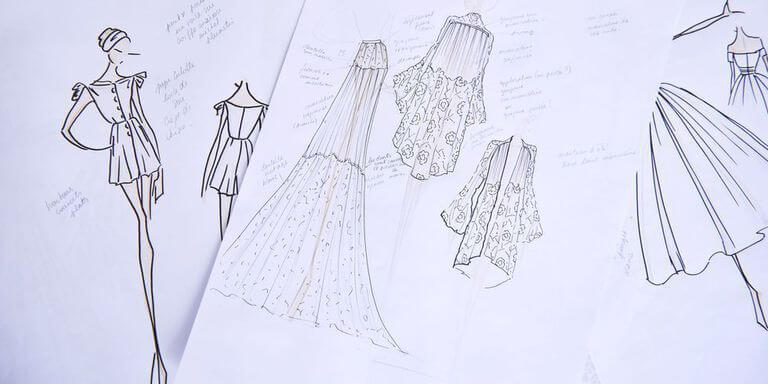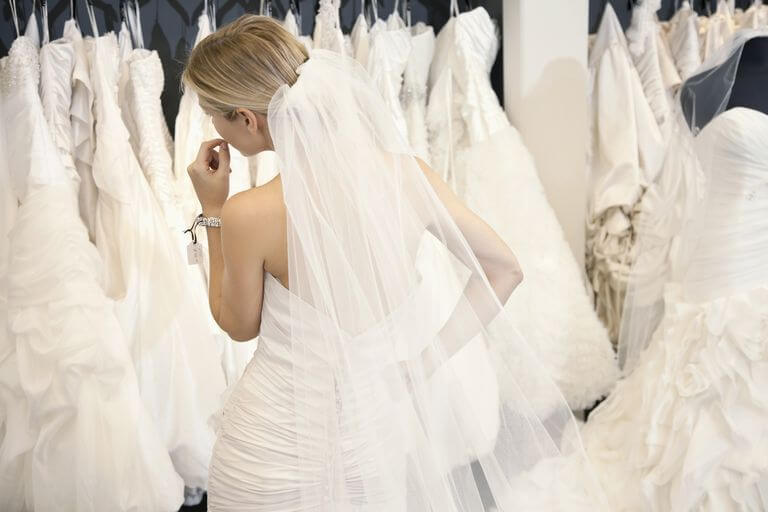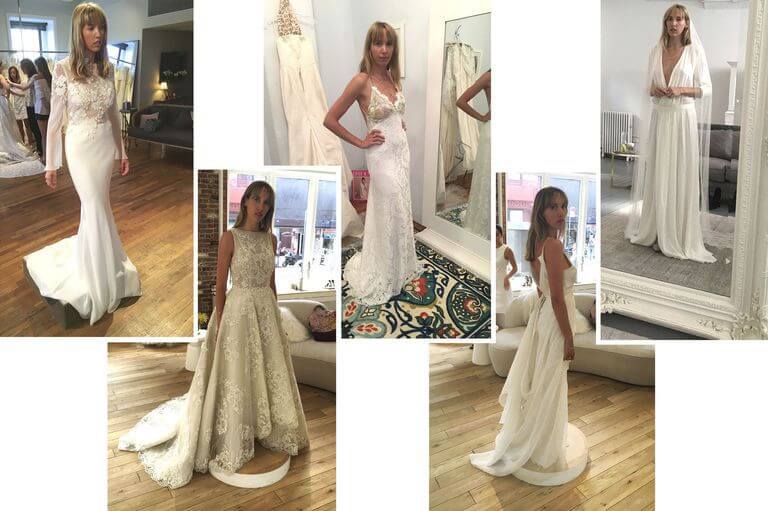[et_pb_section bb_built=”1″][et_pb_row][et_pb_column type=”4_4″][et_pb_text _builder_version=”3.6″]
Sure-fire ways to avoid people on Twitter calling your gown “ill fitting” or “boring.”
Shopping for a wedding gown might not always be as glamorous as the process was for…let’s say, Meghan Markle—but brides tend to make common mistakes that hinder their process of finding the perfect gown. Some mistakes are minor (expert tip: leave your black lace underwear at home and opt for a seamless nude pair to try on wedding gowns), while others can be incredibly detrimental to the process of finding the dress.
And once the dress is decided upon, most brides misstep again, falling prey to tempting “don’ts” that make the process that much more challenging for them in the long run. Here, all the common mistakes brides-to-be make when shopping for their wedding gown—and the ones that will most likely have your friends (or fans) murmuring that your look is “ill-fitting,” “boring” or “bland.”

1. Shopping too late–or too early.
Ideally, brides should begin shopping 10 months prior to their wedding date, and place their gown orders no later than 6-7 months prior to their wedding date—and some would say 6 months is even cutting it close. Bridal gowns are made-to-order, meaning that their creation process does not begin until your measurements are taken, fabric is ordered and your deposit is paid via your local salon. Lead times shorter than 6 months are typically considered rush orders, and you may incur extra fees to receive your gown in time.
When did you think you were supposed to start shopping for a wedding gown?
On the other hand, avoid shopping too soon. Seeing too many gowns too far in advance will cloud your judgement as newer gowns come into the store leading up to your wedding. Bridal gowns are released seasonally, in October and in April, and are shown to buyers a year before they are available in-stores for brides to shop. While it’s always easy to dip into past seasons when shopping for wedding gowns, it’s also key to be patient when you are planning on a long engagement to avoid indecision or (even worse) buyers remorse.
2. Bringing a large entourage.
We’re sure your friends are lovely, but keep your crew small and intimate when wedding dress shopping. Avoid the situation of “too many cooks in the kitchen”—it only takes one negative voice, one (let’s get real) jealous bridesmaid, or a small spat between you and someone you love to destroy the positive tone of a bridal appointment.
Be honest with yourself about the people in your life; who builds you up and who makes you feel insecure? Invite those who love you enough to tell you the truth without being hurtful, and bring along anyone you think understands your personal style, has great taste and can be a real asset in the process—even if that person is not your best friend, mother, grandmother, or future mother-in-law.
Be honest–would you ever hire a bridal stylist?
If you and a family member (let’s say, your mother) have a complicated relationship, maybe it’s best to leave her at home at first. Once you have sorted out what you are looking for, invite her along for a key moment, like a selection appointment or your first fitting. You are your own best editor; cut down on who you should have along for the dress shopping ride, even if the people closest to you are dying to be a part of the process. Going dress shopping solo to start—or hiring a stylist if you feel really lost—is nothing to be ashamed of either.
3. Giving your favorite people too much power.
It may seem simple, but this is your gown, so you should have the final say on its look, feel, and style. In dress shopping appointments, remember that the people you chose to bring along are there to support your decision and help you in the process, rather than hinder you. Ask yourself how you feel before turning to your support system for their opinion. Their loving it or hating it should only come second to how a gown makes you feel. When an opinion contrasts with yours, ask yourself which you trust more. Be wary of those who offer their opinion too quickly; those who speak almost immediately before hearing you out may be trying to help, but their stronger voices can tend to confuse and cloud your judgement.
4. Being unrealistic about your budget.
Go into dress shopping appointments with a game plan: stay in budget. That doesn’t mean you aren’t able to be flexible about how much you are willing to spend, but having a top line number in mind will keep your overall wedding budget in check as well. Still unsure about where to cap your spending? Ask yourself what price tag would turn your “dream dress” into a gown that’s not for you.
How much would you be willing to spend on your dream gown?
Remember, the price tag on your gown doesn’t include alteration fees, accessories, any after party look (should you choose to wear one), your veil, or (post-wedding) dry cleaning and dress preservation. Keep all of those other expenses in mind when deciding what you are comfortable spending on a wedding dress.
5. Incentive Shopping
Should you decide to lose weight, tone, sculpt or go through a dramatic body transformation prior to your wedding, we applaud you and your discipline—but buying a dress based on how you think your future body will look is a mistake. Any consultant worth their salt will not order you a size down based on your promise to lose weight, and you should not request that she consider it. While your alterations may end up being more intensive should you choose to lose weight in the lead up to your wedding, purchasing dresses that don’t fit you now in hopes that they may down the road is a dangerous fashion game plan.
Would you ever order a gown in a size too small?
6. Going in too open or closed minded.
If you love fashion or have been doing your research (ideally via BAZAAR Bridal), you very well may know what you want—but your chosen silhouette may not do your body justice the way it does the model’s. Or, perhaps you have a style in your head, a mental picture of your dream wedding dress, but that imaginary style may not exist exactly as it does in your mind. On the flip side, going in with zero idea of what you want will muddle your goal of narrowing in on the perfect gown.
Try to enter into the dress shopping process with an open mind, but not too open. Have answers to the basic questions you’ll most likely be asked: do you like a full skirt? How do you feel about lace? How do you feel about strapless styles? Or sleeves? Basic silhouette descriptors, the time of year, and the look and feel of your wedding will help your consultant hone in on the best styles to show you.
7. Shopping without context.
Where and what time of year are you getting married? What do you normally feel comfortable in when dressing for a black tie or formal occasion? Asking yourself all of these questions will give you context for what setting your gown will be placed in—and therefore, some guidelines regarding silhouette and style. Are you getting married in a grand cathedral? You may want to consider a longer train and a fuller skirt to fill such a dramatic space.
What type of wedding appeals to you most?
Are you planning a more rustic wedding in a barn, vineyard or country estate? Perhaps a lace or tulle style would suit the ease of your wedding day setting. Consider where your dress is going and the photo moments you’ll be creating on the day. Be prepared to be honest with yourself—the “dream dress” you had in mind might not fully suit the aesthetic of the wedding you are planning.
8. If you can’t handle going custom—don’t.
A custom gown is an acquired taste, and the process typically goes something like this: First, you establish that you are decisive and set in your wedding dress ways enough to collaborate with a designer that best suits your aesthetic. Then, you meet with said designer and discuss your budget, dress dreams, and desired style.

The designer then sketches for you (which can take multiple rounds), offers fabric ideas and once decisions have been made, a muslin is created as a mock-up of your gown, which you and the designer tweak in fittings. Only when the muslin is perfected and approved is the fabric cut and sewn, and then however many fittings are needed ensue, until you end up with your dream gown.
Be honest–could you go custom?
The process is long, repetitive and requires vision, patience, and an understanding that you are likely not going to see your completed wedding gown until very close to your wedding date. If you are not someone who can handle that level of uncertainty and trust wholeheartedly in the designer you have chosen to work with—skip it. Brides with any dose of self-doubt, indecision, or uncertainty are not right for custom.
9. Buying everything all at once.
When you are gown shopping, a bridal consultant will often pair the look you’re leaning towards with a veil to help you envision the look (and make a sale). She may even bring in some additional jewelry, hair accessories or a pair of shoes to give you a real picture of how you could look on the day. You heard it here first: do not buy those things, at least not right away.

Odds are, the accessories your consultant threw on you in your appointment aren’t exactly right for your look, and you need to focus on making sure the order for your gown (and any specific changes you’re asking for related to it) is placed properly. You are about to make one of the largest fashion purchases of your life, save the add-ons for later. They’re a distraction, and they are only being shown to you in hopes that the veil and crystal-encrusted extras will make you feel more like a bride as you stand in a bridal salon, pinned into a sample of a gown that’s seen better days without your hair and makeup done. Trust us, they may be tempting, but those random sparkly extras can wait.
10. Trying on too many gowns.
There comes a time in the shopping process where a sizable amount of options becomes too much. Take it from BAZAAR.com’s very own Olivia Fleming, who tried on 80+ gowns before she found the one. At a certain point, one goes ivory blind and the attention afforded to you in a bridal consultation becomes addictive. Brides who have tried on too many gowns tend to forget the things they really loved about the style that should have been (and will eventually become) their wedding gown, and the alteration process becomes tricky as a result.

Once you order a gown, you wait months for it to come into the salon, and your mind wanders, romanticizing about your dress as you remember it in your head. Trying on too many styles will have you re-appropriating details from try-ons and fittings past, which can complicate alterations. Lastly, brides who have seen too much can lose out on the wow factor of finding the one; it can feel anti-climactic if you’ve chosen to prolong the process and put yourself through dozens of appointments.
[/et_pb_text][/et_pb_column][/et_pb_row][et_pb_row _builder_version=”3.6″][et_pb_column type=”4_4″][et_pb_text _builder_version=”3.6″]
Blogs courtesy harpersbazaar.com
References
These are some of my friends from Bollywood. They are very famous in their own field. Please visit their Website and Instagram pages for details. You can get in touch with us in case you need any help.
[/et_pb_text][/et_pb_column][/et_pb_row][/et_pb_section]